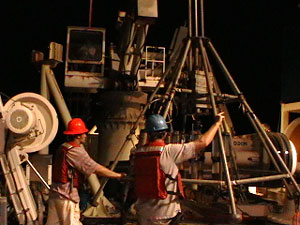

 | |||||||||||
|
|
Journals 2008/2009Cheryl Manning
January 17, 2009 Hello, my name is Paul Walczak. I am a coring technician from Oregon State University onboard the R/V Knorr along with Cheryl. My job on this trip is to assist in the mobilization, rigging, deployment, recovery, and demobilization of all coring equipment during this Costa Rica to Oahu cruise. Additionally, I will join the Knorr in March and April to do a very similar trip in and out of the Galapagos Islands. I should note, that similar for me does not mean that the scientific goals of both trips are in any way related my job is not to know what the samples are used for, but to get the best possible samples for the scientific party.
I am writing this blog so that you can get an idea of who I am, how I ended up as a coring technician, and what I actually do aboard the Knorr. Long story short, I sit in the shade, drink ice water, and watch the science party (Cheryl) do all the hard work. In all seriousness, like you guys, I was once in high school and was fortunate enough (also like you) to have a life science teacher who was interested in oceanography. I took all the classes she offered, and upon graduating in 2000, started chasing after an undergraduate degree in environmental science. Along the way, I discovered that at OSU I could get a minor in oceanography. So I did. During my junior year I began working with a professor in oceanography who was studying deep-living bacteria as part of a NASA project to develop methods to search for extraterrestrial life. One day, he told me that the professor next door wanted to talk to me. Turns out, he was looking for a graduate student. I really hadn't put a lot of thought into my future at that point, and the project sounded very interesting. Two and a half years later, I had been down to the bottom of the ocean in the submersible Alvin, learned how to use several types of mass spectrometer, and written a small book about Cretaceous global ocean anoxia and its possible relationship to large igneous province volcanism (if you find that interesting, feel free to look up my thesis online). I was out of funding, and got an offer to go and help out taking piston cores on a trip from Tahiti to Hawaii. In return, my tuition, fees, and airfare would be paid for. Of course I went! As it turns out, good slave labor must be hard to come by, and I'm still at it several years later (I did successfully defend my Master's degree). At this time I have sailed in every major ocean, been almost to the North Pole, and worked within several miles of my hometown on the Oregon coast. Are you still interested? I'm hoping that reading my little statement beats reading Crime and Punishment. Remember, I could be relaxing and watching Cheryl work. What, exactly, does a coring technician do when he's actually doing something? I'm afraid that I can't answer that with a one-liner, so you'll have to keep reading. First, mobilization! Someone has to think of what needs to come on a trip in order to get cores into an archival state. That means packing and bringing a lot of stuff. In this case it means, literally, tons of stuff. Normally, I physically pack everything myself, but this trip was planned by Woods Hole people so I just had to show up and help get everything ready for the science party. All of the University National Oceanographic Laboratory System (UNOLS) ships have a standard 2-foot on center bolt-hole system on their working decks. If you look closely at any of the photos showing the outside of the ship you will see these deck plugs. This is handy because anything can get bolted to the deck and thus does not have to get welded or tied down. This is how they make the ships very multidisciplinary in nature. It also means that things need to fit to this standard size to go on the boat. For this reason, 20-foot container vans are used. This is similar to what you would see on the back of a semi-truck, except that semis are generally 40 feet. We don't have that much open deck space. If everything for this trip was put into 20-foot vans, we would have needed about 8 vans. Lots of stuff! We moved most of it around and into place before Cheryl and the rest of the science party arrived. The long core system is extremely heavy, so mini train track was built to haul barrels safely at sea. This had to get put together. The corer had to get assembled. I spent a day with one other person plugging in wiring to run the winch and davits necessary to deploy the long core. Another pair of people worked on setting up hydraulics. Then we assembled the gravity, multi, and long coring systems. All of this took us from Tuesday until Sunday in Costa Rica to get assembled and tested. So no vacation there, although being good sailors we got to go out at night.
Perhaps that is enough for now. Maybe in a few days Cheryl will let me tell you how the various coring systems work, and why if we have this fancy new long coring system, do we bother with the primitive stuff. Something for you to think about... Some other questions:
-Paul- |
||||||||||

